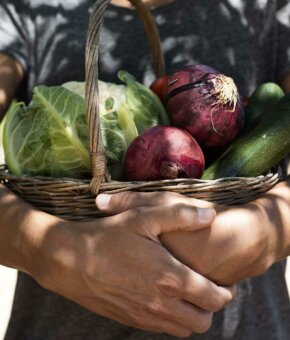
Changing what we eat has a significant impact on meeting climate targets. For healthy people on a healthy planet, we need to shift to a system built around local, regenerative, plant-based, fair, and waste-free diets. How do we get there?
Our food system is one of the biggest contributors to climate change. Water, land use, deforestation and transportation are all leaving a lasting impact on the environment. What if we were able to turn this negative footprint around and instead use our diets as a catalyst for sustainable change? These 5 transitions are great ingredients for a climate-friendly diet and food system:
1. Eat straight from the farm
Shorter food chains have numerous benefits. First of all, they significantly reduce food miles and as such greenhouse gas emitted by transportation. Supporting local initiatives also enables us to restore the lost connection with our food. Many people – especially those living in big cities – don’t know anymore where their food comes from and what it takes to grow fruits and vegetables. Bringing back food production to our cities is a powerful tool to reconnect with our food. Last but not least, eating produce immediately after harvest prevents important nutrient loss. Fruits and vegetables lose their nutritional value during transport and storage. The shorter the time between harvest and consumption, the more nutrients are preserved. Companies like Gotham Greens, that’s building sustainable greenhouses right on top of supermarkets, show us how it can be done.
Related: We are what we eat. This is how we can turn cities into healthy edible oases
2. A plate full of plants
Not only where we buy our food impacts our planet. What we eat matters too – a lot.
Globally, livestock is responsible for one-fifth of all greenhouse gas emissions and the meat industry is one of the biggest drivers of deforestation. Transitioning to a diet – mostly – based on plants is therefore one of the most effective ways to mitigate climate change.
Policymakers play an important role in a transition towards a plant-based food system. However, as writer and environmental specialist George Monbiot states: “It is easier done if the government acts to change the food system but in the absence of that, we should still try and change our diets.”
Companies can offer plant-based options in their company canteens, just like universities and consumers can cook plant-based meals at home. With millions of people around the world eating plant-based – for centuries – the possibilities for tasty, flavorful dishes are endless.
3. Put regenerative farming on the menu
Regenerative farms boost biodiversity, capture CO2 instead of emitting it and grow fertile soils, that in return grow more nutritious crops. Furthermore, farms that work together with nature rather than against it, don’t use pesticides or other chemicals. Incorporating food provided by regenerative farmers into our diets, will make a big impact on the health of both the planet and people.
4. Waste-free diets
Reducing food waste is the most effective solution to combat climate change, according to Project Drawdown. In all parts of the chain, food is wasted, which also means that everybody can contribute to the solution, from consumers to restaurant owners. Waste isn’t waste until we waste it!
Bringing sustainable food production back to the city is a key component to waste-free diets, explains food waste expert Toine Timmermans: “Especially for very perishable products like salads and herbs, short supply chains are a great way to prevent wastage during transport.” By including as much local food as possible into our diets, we directly lower our food waste impact. At home, consumers can make a difference too. With so many easy, delicious, and creative recipes out there, eating to minimise food waste has never been more fun.
Related: With ‘De Clique’ Anja Cheriakova is creating the model for zero waste cities
5. Fair access to climate-friendly diets
A transition to a diet that is beneficial to both planet and people will only be successful if there’s equal access to organic, nutritious, and locally produced food. This means transforming food deserts into flourishing edible areas and supporting bottom-up change, as well as a shift in the mindset of city governments, where food is no longer seen as an economic asset, but as a vehicle that we can use to regenerate the planet and with equal access for everyone.
Whether you are a consumer, food producer, urban planner, or policymaker, we can all contribute to the transition towards climate-friendly diets. Do you want to learn more about how you can make a difference? Watch our documentary or sign up for our monthly newsletter.



